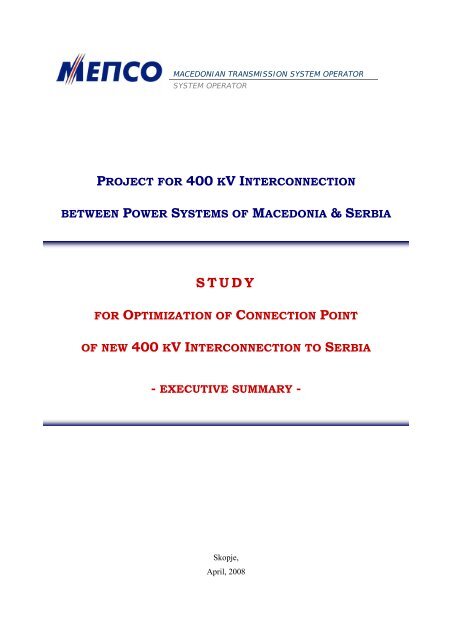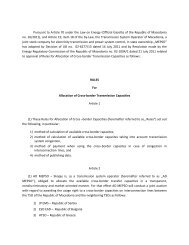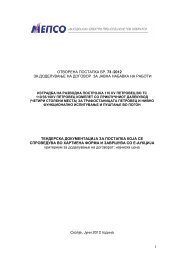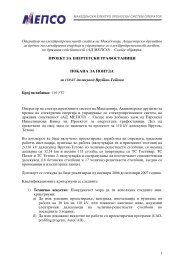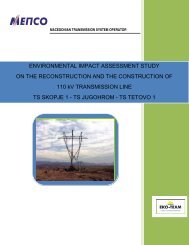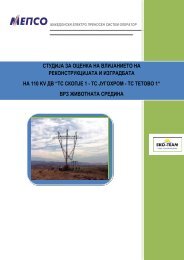project for 400 kv interconnection between power systems of ...
project for 400 kv interconnection between power systems of ...
project for 400 kv interconnection between power systems of ...
- No tags were found...
Create successful ePaper yourself
Turn your PDF publications into a flip-book with our unique Google optimized e-Paper software.
MACEDONIAN TRANSMISSION SYSTEM OPERATORSYSTEM OPERATORPROJECT FOR <strong>400</strong> KV INTERCONNECTIONBETWEEN POWER SYSTEMS OF MACEDONIA & SERBIASTUDYFOR OPTIMIZATION OF CONNECTION POINTOF NEW <strong>400</strong> KV INTERCONNECTION TO SERBIA- EXECUTIVE SUMMARY -Skopje,April, 2008
Study <strong>for</strong> Optimization <strong>of</strong> Connection Point <strong>of</strong> new <strong>400</strong> kV Interconnection to SerbiaStudyCoordinator:Author<strong>of</strong> the Analysis:Elizabeta S. AtanasovaAD MEPSO – SkopjePower System Planning and Analyzesbetas@mepso.com.mkKliment NaumoskiAD MEPSO – SkopjePower System Planning and Analyzesknaumoski@mepso.com.mkii
Study <strong>for</strong> Optimization <strong>of</strong> Connection Point <strong>of</strong> new <strong>400</strong> kV Interconnection to SerbiaCONTENT1. BASIC INFO FOR THE PROJECT AND THE STUDY ................................................................... 42. VARIANTS FOR CONNECTION POINT.......................................................................................... 53. TECHNO-ECONOMICAL ANALYSIS .............................................................................................. 63.1. NETWORK MODELS AND POWER EXCHANGE SCENARIOS .................................................................... 63.2. TECHNICAL CRITERIA FOR NETWORK PLANNING ................................................................................ 83.3. RESULTS OF TECHNICAL ANALYSIS .................................................................................................... 83.4. ECONOMICAL CRITERIA FOR EVALUATION OF VARIANTS.................................................................. 113.5. ECONOMICAL PARAMETERS OF VARIANTS........................................................................................ 123.6. ADDITIONAL BENEFITS OF NEW INTERCONNECTION ......................................................................... 134. CONCLUSION ..................................................................................................................................... 14iii
Study <strong>for</strong> Optimization <strong>of</strong> Connection Point <strong>of</strong> new <strong>400</strong> kV Interconnection to Serbia1. BASIC INFO FOR THE PROJECT AND THE STUDYTransmission system operators <strong>of</strong> Macedonia (MEPSO) and Serbia (EMS) have initiated <strong>project</strong><strong>for</strong> construction <strong>of</strong> <strong>400</strong> kV <strong>interconnection</strong> line <strong>between</strong> their <strong>power</strong> <strong>systems</strong>. Two feasibility studies arecompleted so far, investigating basic technical characteristics and viability <strong>of</strong> the <strong>project</strong>:– Technical and Economical Aspects <strong>for</strong> Interconnection <strong>of</strong> Power Systems<strong>of</strong> Serbia and Macedonia with <strong>400</strong> kV OHL Nis – Leskovac – (Vranje) – Skopje,EKC & EPS – Belgrade, ESM – Skopje;– Study <strong>for</strong> new <strong>400</strong> kV <strong>interconnection</strong> lines <strong>between</strong> Macedonia – Serbiaand Albania – Montenegro,TEN – <strong>project</strong>, HTSO – Athens, ESM – Skopje, EKC & EPS – Belgrade, EPCG – Podgorica,KESH – Tirana.At present there are three <strong>interconnection</strong> lines <strong>between</strong> electric <strong>power</strong> system <strong>of</strong> Macedonia andneighbouring system on the north: one OHL on <strong>400</strong> kV voltage level and two 220 kV OHL-s that connectregions <strong>of</strong> Skopje and Kosovo. Skopje is region in the country with the largest demand. Electricity supply <strong>of</strong>Skopje region is mainly covered from TPP Bitola production and imports through north interface anddistributed by two <strong>400</strong> kV nodes: SS Skopje 5 and SS Skopje 4. In a last few years, unavailability <strong>of</strong> 220 kV<strong>interconnection</strong>s that are out <strong>of</strong> operation since 1999 has deteriorated reliability <strong>of</strong> <strong>power</strong> <strong>systems</strong> in theregion.Unavailability <strong>of</strong> 220 kV OHL-s to Kosovo affects electricity exchange in north – south direction,mostly in summer months while Greece has peak demand and big imports from other <strong>power</strong> <strong>systems</strong>.Transmission capacity <strong>of</strong> the whole <strong>interconnection</strong> north – south is decreased: Nis – Kosovo – Skopje –Dubrovo – Thessaloniki. Outage <strong>of</strong> <strong>400</strong> kV busbars in SS Kosovo is especially dangerous regime. Electricityflowing to south overload the rest <strong>of</strong> <strong>interconnection</strong> links (220 kV OHL Prizren – Fierza, 220 kV OHLPodgorica – Vau Dejes and <strong>400</strong> kV OHL Blagoevgrad – Thessaloniki) that can lead to cascade outages and<strong>power</strong> supply interruptions <strong>of</strong> particular regions. In fact, similar events have been reason <strong>for</strong> blackout <strong>of</strong><strong>systems</strong> in Macedonia, part <strong>of</strong> Greece, Serbia and Montenegro on 25 th August 2007. Situation is critical inthe period <strong>of</strong> overhauls <strong>of</strong> other capital electricity facilities as well. Constantly increasing bulk <strong>power</strong>exchange <strong>between</strong>/through EPS-s <strong>of</strong> Macedonia and Serbia impose construction <strong>of</strong> new <strong>interconnection</strong> linenecessary.New link toward north will significantly improve quality, flexibility and reliability <strong>of</strong> <strong>power</strong> supply<strong>of</strong> Skopje. Construction <strong>of</strong> this <strong>400</strong> kV line is important <strong>for</strong> both <strong>systems</strong>. It will improve security, reliabilityand operability <strong>of</strong> the wider region and create conditions <strong>for</strong> larger amount <strong>of</strong> electricity exchange.Realization <strong>of</strong> <strong>400</strong> kV OHL to Nis (SER), together with recently established <strong>400</strong> kV OHL Bitola(MKD) – Florina (GRE) and ongoing construction <strong>of</strong> <strong>400</strong> kV OHL Stip (MKD) – Chervena Mogila (BUL)will strengthen electricity corridor north – south, multiplying transmission capacities.According to preliminary plans <strong>for</strong> new <strong>400</strong> kV <strong>interconnection</strong>, it will be designed as single circuit<strong>400</strong> kV line with lattice type steel towers with bundle <strong>of</strong> two conductors per phase, type Al/Fe 490/65mm 2 /mm 2 . On the Serbian territory, OHL starts at <strong>400</strong>/220 kV SS Nis. In order to improve <strong>power</strong> supply insouthern part <strong>of</strong> Serbia, two new <strong>400</strong> kV substation will be build and connected on this line: SS Vranje andSS Leskovac. Length <strong>of</strong> the line from SS Nis to Macedonian – Serbian border is about 150 km.Connection point on Macedonian side is still not defined. Interconnection may be connected eitherin one <strong>of</strong> existing <strong>400</strong>/110 kV substations in Skopje, SS Skopje 5 or SS Skopje 4, or in planned <strong>400</strong>/110 kVSS Stip. Having intention to make right choice <strong>of</strong> connection point on Macedonian territory <strong>of</strong> new<strong>interconnection</strong>, MEPSO carried out techno-economical analyses that identify the best solution.4
Study <strong>for</strong> Optimization <strong>of</strong> Connection Point <strong>of</strong> new <strong>400</strong> kV Interconnection to Serbia2. VARIANTS FOR CONNECTION POINTMEPSO experts considered a lot <strong>of</strong> variants <strong>for</strong> connection point during preparation phase <strong>of</strong> the<strong>project</strong> <strong>for</strong> new <strong>interconnection</strong>. On the beginning, variants have been analyzed from the viewpoint <strong>of</strong>availability <strong>of</strong> spatial corridors <strong>for</strong> OHL-s, possibilities <strong>for</strong> accessing and upgrading candidate substations aswell as possibilities <strong>for</strong> practical accomplishment <strong>of</strong> variants and economical characteristics <strong>of</strong> investment.Figure 1. Corridors (in dark blue) <strong>for</strong> new <strong>interconnection</strong>s to northern EPS-sIn the meantime, creation <strong>of</strong> second <strong>interconnection</strong> link <strong>between</strong> system <strong>of</strong> Kosovo andMacedonia has been initiated. For this purpose is <strong>for</strong>eseen to use at least one <strong>of</strong> existing 220 kV OHL-sSkopje 1 – Kosovo A, by refurbishment <strong>of</strong> one <strong>of</strong> the lines or by using the corridor <strong>for</strong> construction <strong>of</strong> newline on <strong>400</strong> kV voltage level. Existing 220 kV lines Skopje 1 – Kosovo A are out <strong>of</strong> operation <strong>for</strong> a long timeand are highly deteriorated on the territory <strong>of</strong> Kosovo. Decision on voltage level <strong>of</strong> second <strong>interconnection</strong> toKosovo is interdependent on future <strong>of</strong> 220 kV voltage level in Macedonia. Development plans <strong>of</strong>Macedonian EPS do not consider expansion <strong>of</strong> 220 kV level, but plan is to discard this voltage level. Thatmeans that second link to Kosovo should be implemented on <strong>400</strong> kV voltage level with adequate choice <strong>of</strong>connection point in Macedonian network. Variants in the Study consider these possibilities as well, makingan ef<strong>for</strong>t <strong>for</strong> simultaneous optimization <strong>of</strong> two new links towards north: second line to Kosovo and new <strong>400</strong>kV line to Nis (i.e. to Vranje – Leskovac – Nis).Based on a<strong>for</strong>ementioned findings and conclusions, few variants are defined and technoeconomicalanalyzes are per<strong>for</strong>med.5
Study <strong>for</strong> Optimization <strong>of</strong> Connection Point <strong>of</strong> new <strong>400</strong> kV Interconnection to SerbiaKosovo BNisS<strong>of</strong>iaKosovo BNisS<strong>of</strong>iaKosovo ASkopje 5Skopje 4C. MogilaSkopje 5Skopje 4C. MogilaStipBitola Dubrovo BlagoevgradBitola Dubrovo BlagoevgradFlorinaThessalonikiFlorinaThessalonikisituation 2007 1 2Kosovo BNisS<strong>of</strong>iaSkopje 5Skopje 4KumanovoC. MogilaStipBitola Dubrovo BlagoevgradFigure 2. Variants <strong>for</strong> connection pointFlorinaThessaloniki3а 3b 3c3. TECHNO-ECONOMICAL ANALYSIS3.1. NETWORK MODELS AND POWER EXCHANGE SCENARIOSTransmission network modelPlanning model <strong>for</strong> the reference year 2015 is used in analyzes. This model represents thedevelopment <strong>of</strong> Macedonian <strong>power</strong> system in mid-term period according to <strong>for</strong>eseen new plants andsubstations. Macedonian model is integrated in SECI regional model <strong>for</strong> 2010, whereas all planned<strong>interconnection</strong>s from Macedonia to neighbouring <strong>systems</strong> are assumed in operation:– <strong>400</strong> kV OHL Bitola – Florina (Greece);– <strong>400</strong> kV OHL Dubrovo – Stip – C. Mogila and <strong>400</strong>/110 kV SS Stip;– <strong>400</strong> kV OHL Bitola – Elbasan – Tirana – Durres (Albania) – Foggia (Italy);– Commencement <strong>of</strong> additional <strong>interconnection</strong> to Kosovo on <strong>400</strong> kV voltage level.Peak load demand is considered; this regime is typical in winter period (December – January),assuming normal climate and hydrological conditions. Concerning Macedonian electricity balance, <strong>for</strong>ecastdemand is 1740.5 MW; in the base case 100 MW are coming from import and the rest is covered bydomestic production.6
Study <strong>for</strong> Optimization <strong>of</strong> Connection Point <strong>of</strong> new <strong>400</strong> kV Interconnection to SerbiaElectricity exchange scenariosLong-term development strategy <strong>for</strong> production capacities in South-eastern Europe definesdifferent locations <strong>for</strong> new <strong>power</strong> plants. Kosovo has ambitious development program <strong>for</strong> production <strong>of</strong>electricity that will be partially export, although Kosovo is expected to have deficit on a short and mediumterms. Bulgaria intends to develop production facilities and to keep its exporter status. Romania is also largeexporter in SEE region and likely will have the same role in the future. Power balance <strong>of</strong> Greece depends onhydrological conditions. Grand development plans <strong>of</strong> Greece in wind <strong>power</strong> should be also considered.Establishment <strong>of</strong> regional electricity market will give incentive <strong>for</strong> numerous electricity tradingarrangements on daily and long term basis. From the other side, Italy as a system with highest electricityprice in Europe, significantly higher then price levels in Balkans, is orienting on utilization and benefit fromcost-effective capacities in SEE countries with extra <strong>power</strong>.It is obvious that will be huge and highly assessable number and direction <strong>of</strong> transactions acrossregional network. However, three scenarios <strong>of</strong> electricity exchanges investigated in these analyzes isexpected to reflect most typical and most probable operational regimes in transmission network.500 MW150 MW500 MWFigure 3. Scenario 1: North → South 1500 MW1000 MW200 MWFigure 4. Power balance in SEE<strong>for</strong> base case exchange scenarioFigure 5. Scenario 2: East → West 1000 MW7
Study <strong>for</strong> Optimization <strong>of</strong> Connection Point <strong>of</strong> new <strong>400</strong> kV Interconnection to Serbia3.2. TECHNICAL CRITERIA FOR NETWORK PLANNINGMinimum level <strong>of</strong> network technical redundancy must be provided all the time in order to insurenormal operation <strong>of</strong> the system, even in contingency cases with unavailable elements. It is clear that isimpractical to achieve satisfying redundancy that can insure all combination <strong>of</strong> unavailable elements.There<strong>for</strong>e, TSO-s have different operative and planning criteria which are using to achieve high efficiencyand acceptable level <strong>of</strong> network reliability.3.3. RESULTS OF TECHNICAL ANALYSISN – 0 and N – 1 analysisDuring N–0 analysis (regimes without contingency events), <strong>for</strong> all variants <strong>of</strong> connection point,there are not detected overloaded elements neither voltage deviation out <strong>of</strong> defined values in transmissionsystem.System’s adequacy is checking with N–1 criterion. These outages have been simulated:- all <strong>interconnection</strong>s in SEE transmission system;- all elements (lines, trans<strong>for</strong>mers and generators) in Macedonian transmission system;- 220 and <strong>400</strong> kV lines in <strong>systems</strong> <strong>of</strong> Greece, Bulgaria, Kosovo, Serbia and Albania.While analyzing variants, regime parameters are monitored if there value is out <strong>of</strong> voltage andthermal limits.If some variant is detected that breach technical criteria, then this variant is eliminated likeunfavourable. Usually, variants which have more problematical contingency regimes are not taken in furtheranalysis.N–1 analyses have detected a few problematical regimes with outages on specific elements in theregion. Described regimes are appearing in all three scenarios <strong>of</strong> exchange, in the basic topology and in allvariants <strong>of</strong> connection point. Critical regimes have a local character and depend <strong>of</strong> network’s localconfiguration. These problems are not influenced neither are solved with suggested variants <strong>for</strong> realization <strong>of</strong>new <strong>interconnection</strong>s toward the north <strong>systems</strong>. Analyses <strong>for</strong> all variants confirm that they fill N–1 criteria.According to the National Grid code <strong>for</strong> electricity transmission, extreme and less probableoutages, like faults on busbars do not need to be included in the planning. Moreover, the transmissionnetwork <strong>of</strong> the ex-Yugoslav countries is built according to the same principle with acceptable risks <strong>of</strong>busbars outages. However, some <strong>of</strong> the variants deserve to be analyzed from the aspect <strong>of</strong> busbars outagesand their consequences on the global per<strong>for</strong>mance <strong>of</strong> the network. Two <strong>of</strong> the variants are predicting networkconfiguration with a bus with three <strong>interconnection</strong>s; it is SS Skopje 5 in variant 1 and SS Kumanovo invariant 3b. That means that during an outage <strong>of</strong> <strong>400</strong> kV busbars in SS Skopje 5, i.e. SS Kumanovo, three<strong>interconnection</strong>s will be disconnected and the transit in the region will be endangered. In the other variants,the maximum number <strong>of</strong> <strong>interconnection</strong>s connected at the same point is two. Variants 1 and 3b areevaluated as less acceptable according to this criterion.Active <strong>power</strong> lossesIn the basic network topology <strong>of</strong> base case exchange scenario, losses <strong>of</strong> active <strong>power</strong> in theMacedonian <strong>power</strong> system are 23.7 MW and in the regional network are 1726.2 MW. New <strong>interconnection</strong>swith the northern <strong>systems</strong> are reducing losses <strong>of</strong> the active <strong>power</strong> in the regional transmission network (from1.41 MW in variant 1 to 2.05 MW in variant 3b). Because <strong>of</strong> the increased transits, losses in the Macedoniansystem are increasing <strong>for</strong> a small value (from 60 kW to 150 kW depending on the variant).Compared to the base case exchange scenario, additional transit <strong>of</strong> 1500 MW from north to southgenerates bigger losses in the regional transmission network. New <strong>interconnection</strong>s with the northern<strong>systems</strong> are reducing active <strong>power</strong> losses in the regional transmission system (from 1.49 MW in variant 3a to8
Study <strong>for</strong> Optimization <strong>of</strong> Connection Point <strong>of</strong> new <strong>400</strong> kV Interconnection to Serbia4.12 MW in variant 3c). Losses in the Macedonian system in variants 2, 3a and 3b are increased <strong>for</strong> a smallamount, and due to improved flow distribution in variant 1 and 3c losses are smaller <strong>for</strong> 200 kW and 60 kW,respectively.Similar to this, in scenario 2, new <strong>interconnection</strong>s with the northern <strong>systems</strong> are reducing losses <strong>of</strong>active <strong>power</strong> in the regional transmission network (from 1.87 MW in variant 1 to 4 MW in variant 3b).Because <strong>of</strong> the increased transit, losses in the Macedonian system are increased <strong>for</strong> a small value (from50 kW to 600 kW, depending on the variant).17321731Losses in SEE[MW]Base case scenario18501849Losses in SEE[MW]Scenario 117601759Losse in SEE[MW]Scenario 21730184817581729184717571728184617561727184517551726184417541725184317531724184217521723184117511722var 0 var 1 var 2 var 3a var 3b var 3c1840var 0 var 1 var 2 var 3a var 3b var 3c1750var 0 var 1 var 2 var 3a var 3b var 3cFigure 6. Active <strong>power</strong> losses in EPS-s in SEEActive <strong>power</strong> transitsIn base case exchange scenario with the basic network topology, transits <strong>of</strong> active <strong>power</strong> in theMacedonian transmission system are 220 MW. Transits through our network are increased as a result <strong>of</strong>building the new <strong>interconnection</strong> lines, from 39 MW in variant 1 to 103 MW in variant 3b.In the basic network topology <strong>for</strong> exchange scenario 1, transits <strong>of</strong> active <strong>power</strong> through theMacedonian transmission network are about 387 MW. With building new <strong>interconnection</strong> lines, biggertransits through our country are achieved (up to 46.5 MW in variant 3c).Active <strong>power</strong> transits through the Macedonian transmission system <strong>for</strong> scenario 2, in the basicnetwork topology, are about 453 MW. With building new <strong>interconnection</strong> lines, bigger transits are achievedin range from 41 MW in variant 1 to 134 MW in variant 3b.350325MKD transit[MW]Base case scenario450425MKD transit[MW]Scenario 1600.0575.0MKD transit[MW]Scenario 2300<strong>400</strong>550.0275375525.0250350500.0225325475.0200var 0 var 1 var 2 var 3a var 3b var 3c300var 0 var 1 var 2 var 3a var 3b var 3c450.0var 0 var 1 var 2 var 3a var 3b var 3cFigure 7. Active <strong>power</strong> transits through EPS <strong>of</strong> Macedonia9
Study <strong>for</strong> Optimization <strong>of</strong> Connection Point <strong>of</strong> new <strong>400</strong> kV Interconnection to SerbiaTransmission capacitiesIn calculation <strong>of</strong> transmission capacities, the exchange <strong>of</strong> energy can be simulated <strong>between</strong>following areas:– TBC <strong>for</strong> northern Macedonian interface[BUL + SER + MN] ↔ [MKD + GRE +ALB]– TBC <strong>for</strong> southern Macedonian interface[MKD + BUL + SER + MN] ↔ [GRE +ALB]ROBIHSRMNBGMKALGRFigure 8. Definition <strong>of</strong> import/export areas <strong>for</strong> TBC calculationIn most <strong>of</strong> the cases, during calculation <strong>of</strong> transmission capacities, critical event is outage <strong>of</strong> onecircuit <strong>of</strong> double circuit <strong>400</strong> kV line S<strong>of</strong>ia West – C. Mogila, which leads to overloading <strong>of</strong> the secondcircuit. Only in calculation <strong>of</strong> transmission capacities <strong>of</strong> the southern interface in variants 3a and 3b, outage<strong>of</strong> the new <strong>400</strong> kV <strong>interconnection</strong> Filippi (Greece) – Maritza East (Bulgaria) can cause overloading <strong>of</strong> theplanned <strong>400</strong> kV <strong>interconnection</strong> Kexru (near to Filippi, Greece) – Babaeski (Turkey).Analyses show that bottlenecks <strong>of</strong> the cross border transmission are located in the eastern parts <strong>of</strong>the regional transmission network. Building new <strong>interconnection</strong>s will strengthen the network and the majorpart <strong>of</strong> the transits will be drawn in the middle part, through Macedonian network. Consequently, flows onoverloaded critical lines are reduced and transmission capacities <strong>of</strong> the network are increased.Variant 3b has the smallest influence on increasing TBC, in reference to basic network topology.Variant 3a has the biggest growth <strong>of</strong> TBC on the northern interface <strong>of</strong> 259 MW. This variant causes thebiggest increase <strong>of</strong> the capacity <strong>for</strong> the whole region also, <strong>for</strong> over 500 MW. Variant 2 causes the biggestincrease <strong>of</strong> the capacity on the southern interface <strong>for</strong> over 187 MW.10
Study <strong>for</strong> Optimization <strong>of</strong> Connection Point <strong>of</strong> new <strong>400</strong> kV Interconnection to Serbia700TBC [MW]North <strong>interconnection</strong>1000TBC [MW]South <strong>interconnection</strong>650950600900550850500800450750<strong>400</strong>var 0 var 1 var 2 var 3a var 3b var 3c700var 0 var 1 var 2 var 3a var 3b var 3cFigure 9. Graphical representation <strong>of</strong> transmission capacitiesShort-circuit currentsFor normal operation <strong>of</strong> the <strong>power</strong> system it is necessary to fulfill following condition: maximumvalue <strong>of</strong> short-circuit current in each bus <strong>of</strong> the system must be smaller in reference to breaking current <strong>of</strong> thedevices installed in that bus. During the planning, the maximum level <strong>of</strong> the short-circuit faults is checked inorder to confirm compatibility <strong>of</strong> existing equipment and dimensioning the new equipment, using mediumterm <strong>for</strong>ecast model. The calculations are made according to an optimistic scenario <strong>for</strong> the expansion <strong>of</strong> thesystem, supposing that all major <strong>project</strong>s <strong>for</strong> the expansion <strong>of</strong> the network are already released.The biggest short-circuit current are expected at 110 kV busbars in SS Skopje 1 and SS Skopje 4.Variant 1 has the maximal growth <strong>of</strong> 3-phase and 1-phase fault in Skopje 1 and Skopje 4, their values are2.4 kA/ 2.3 kA and 1.9 kA/1.8 kA, respectively. 1-phase fault on 110 kV busbars in SS Skopje 1 is 38.3 kA.This value can be considered critical because it almost reaches rated breaking <strong>power</strong> <strong>of</strong> high voltageequipment in the substation. Primary reason <strong>for</strong> high value <strong>of</strong> short circuit fault is high density <strong>of</strong> <strong>400</strong> kVlines and production units at/near this bus (in variant 1 there are three <strong>interconnection</strong>s at Skopje 5 * ). Thisvalue is unacceptably high and is recommended to avoid variant 1 as a potential solution.3.4. ECONOMICAL CRITERIA FOR EVALUATION OF VARIANTSEconomical comparison <strong>of</strong> the variants is done with the pr<strong>of</strong>itability index method bydetermination <strong>of</strong> cost/benefit ratio. Costs/benefits <strong>of</strong> the variants are converted to equivalent annual valueand pr<strong>of</strong>itability index r is calculating.r =B( A+O).B (benefit) is equivalent benefit per year from:– Reduced losses <strong>of</strong> active <strong>power</strong> and energy;– Revenue from the increased transmission capability due to revenue <strong>of</strong> renting transmissioncapacity in cases <strong>of</strong> congestion;* In fact, Skopje 5 and Skopje 1 is the same substation, where Skopje 1 refers to 110 kV busbars andswitchyards and Skopje 5 refers to <strong>400</strong> kV busbars and switchyards. Skopje 5 and Skopje 1 are connected with two<strong>400</strong>/110 kV autotrans<strong>for</strong>mers, with 300 MVA each unit.11
Study <strong>for</strong> Optimization <strong>of</strong> Connection Point <strong>of</strong> new <strong>400</strong> kV Interconnection to Serbia– Revenue from transit redistribution.Equivalent costs per year (A+O) include annuity <strong>of</strong> investments A and operational costs O.3.5. ECONOMICAL PARAMETERS OF VARIANTSInvestment costsIn Table 1 are given investment costs <strong>for</strong> execution <strong>of</strong> Macedonian part <strong>of</strong> planned<strong>interconnection</strong>s, <strong>for</strong> different variants. Standard planning values <strong>of</strong> construction prices <strong>for</strong> <strong>400</strong> kVtransmission lines and line switchgears are used.Table 1. Investment costslength <strong>of</strong>single circuit OHL[km]unit price[€/km]length <strong>of</strong>double circuit OHL[km]unit price[€/km]Investment in OHL[€]OHL switchgear[units]unit price[€/unit]Investmentin OHL switchgear[€]TotalInvestmentVariant 1 74 14,800,000 2 1,800,000 16,600,000Variant 2 89 17,800,000 2 1,800,000 19,600,000Variant 3a 38 200,000 28 325,000 16,700,000 4 900,000 3,600,000 20,300,000Variant 3b 75 28 24,100,000 4 3,600,000 27,700,000Variant 3c 85 12 20,900,000 4 3,600,000 24,500,000Revenue from reduction <strong>of</strong> active <strong>power</strong> lossesIn the base network topology losses <strong>of</strong> active <strong>power</strong> in different exchange scenarios (without new<strong>interconnection</strong>s) are reference values <strong>for</strong> estimating the variation <strong>of</strong> losses in different variants. Price <strong>for</strong>electricity losses is equal to market electricity price and is estimated on 75 €/MWh.Revenue from capacity allocationBuilding <strong>of</strong> new <strong>interconnection</strong> is expecting to increase transmission capacity <strong>of</strong> network in northsouthdirection. According to the rule “no congestion – no payment” there is possibility increased capacity tosatisfy the demand <strong>of</strong> transmission capacity and it will brings abolition <strong>of</strong> costs <strong>for</strong> capacity allocation. But ifit is supposed that southern <strong>power</strong> <strong>systems</strong> (Macedonia, Greece, Albania and Italy) will have deficit <strong>of</strong> <strong>power</strong>in the future, it is more likely that the demand <strong>of</strong> transmission capacity will be always bigger then the <strong>of</strong>fer.MEPSO have on disposal half <strong>of</strong> the revenues from allocation <strong>of</strong> transmission capacity <strong>of</strong> system<strong>interconnection</strong>s. Supposed price <strong>for</strong> capacity allocation is 5 €/MWh.Revenues from redistribution <strong>of</strong> transitsTransits through Macedonian system are growing with building the transmission network andincreasing the number <strong>of</strong> <strong>interconnection</strong>s. There<strong>for</strong>e, with building the new <strong>interconnection</strong>, MEPSO isexpecting to make additional pr<strong>of</strong>it from the increased transits, and the value <strong>of</strong> this revenue is a different <strong>for</strong>a different variant <strong>of</strong> connection point. In the next period, transit’s price is expected to be above 2.5 €/MWh.12
Study <strong>for</strong> Optimization <strong>of</strong> Connection Point <strong>of</strong> new <strong>400</strong> kV Interconnection to SerbiaTotal revenuesIn Table 2 are given total revenues. Biggest positive effects have variant 3c and smallest havevariant 3a.Table 2. Total Benefits BLossesReductionTransmissionCapacityAlocationTransitIncreaseTotalBenefitVariant 1 1,908,990 730,575 878,730 3,518,295Variant 2 1,903,680 941,<strong>400</strong> 1,141,920 3,987,000Variant 3a 1,250,820 928,800 952,110 3,131,730Variant 3b 1,452,600 668,025 1,428,810 3,549,435Variant 3c 2,045,160 951,300 1,087,350 4,083,810Pr<strong>of</strong>itability indexIn Table 3 is given pr<strong>of</strong>itability index <strong>for</strong> all variants.Table 3. Pr<strong>of</strong>itability index rRanking I i n A O B rVariant 1 16,600,000 1,543,130 902,000 3,518,295 1.44Variant 2 19,600,000 1,822,008 1,052,000 3,987,000 1.39Variant 3a 20,300,000 9% 40 1,887,080 1,159,000 3,131,730 1.03Variant 3b 27,700,000 2,574,981 1,529,000 3,549,435 0.86Variant 3c 24,500,000 2,277,510 1,369,000 4,083,810 1.12According to economic analysis the biggest benefit are achieved with variant 1 and variant 2.Variant 2 is on the second place because <strong>of</strong> bigger investment costs. Considering the fact that the corridor <strong>for</strong>connections in variant 1 pass through urban territory, increasing <strong>of</strong> contingency costs could be expected.Also, preliminary length <strong>of</strong> the connection to Stip in variant 2 is coarse estimation which can be reduced infollowing optimization process <strong>of</strong> the corridor. These are the facts that make variant 2 economicalcompetitive to variant 1.Benefits from other three variants 3a, 3b and 3c are smaller. These three variants proposepremature investment in <strong>400</strong> kV switchgear in Kumanovo; in fact Kumanovo substation should becommissioned later. Even in variant 3, which brings the biggest revenue, it is not possible to justifypremature investment <strong>of</strong> switchgear in Kumanovo.3.6. ADDITIONAL BENEFITS OF NEW INTERCONNECTIONThree applied revenues are chosen because provide clear comparison <strong>between</strong> the different variants<strong>for</strong> connection point and because they give opportunity to quantify and choose the optimal solution. Thisrevenue has direct influence <strong>of</strong> MEPSO’s income and can be accurately estimated.Economy analysis <strong>of</strong> this study has no intention to show economical justification <strong>of</strong> investment <strong>for</strong>the new <strong>interconnection</strong>. But it is worth mentioning that beside considered revenues, due to construction <strong>of</strong>the <strong>interconnection</strong> other pr<strong>of</strong>its will be realized as well, which are difficult <strong>for</strong> quantitative valorisation.Firstly, new <strong>interconnection</strong> will contribute in levelling the <strong>power</strong> price in the region. In the region,Greece’s system has a deficit <strong>of</strong> <strong>power</strong> and during whole year it buys <strong>power</strong> from other countries in order tocover own consumption. Romania and Bulgaria are countries in the region that have <strong>power</strong> surplus. Bosniaand Herzegovina is country that has <strong>power</strong> surpluses in the specific periods. In the same time, there is adifference in <strong>power</strong> price <strong>between</strong> the countries that exports and the countries that imports <strong>power</strong>. Alwaysthe bigger <strong>power</strong> price is in the countries that imports <strong>power</strong> because <strong>of</strong> the additional costs <strong>for</strong> allocation <strong>of</strong>transmission capacity, transit fee and traders’ revenue. Larger transmission capacity and more developed13
Study <strong>for</strong> Optimization <strong>of</strong> Connection Point <strong>of</strong> new <strong>400</strong> kV Interconnection to Serbia<strong>power</strong> market leads to lower <strong>power</strong> price in the countries that imports. Also, countries that exports electricitypr<strong>of</strong>it from opening the market because can <strong>of</strong>fer their products <strong>for</strong> a bigger price.Different countries in the region have peak load in different periods <strong>of</strong> the year. Because the new<strong>interconnection</strong> transmission capacities are enlarged it allows to use bigger part <strong>of</strong> the other countries’reserve in order to cover regimes with peak load. It reduces the investment in installed production capacity <strong>of</strong>national <strong>power</strong> reserve.Increased transmission capacity and market development are condition <strong>for</strong> promoting the regionaldispatch which brings lower production costs on global level because <strong>of</strong> accessibility <strong>of</strong> units with a differenttype <strong>of</strong> prime movers and low price <strong>for</strong> production.Other effects come from telecommunication services which are achieving by installing opticalgrounding wires in new <strong>interconnection</strong>s. This feature eliminates EMS’s and MEPSO’s costs <strong>for</strong> rentingtelecommunication channels and at the same time there is possibility to <strong>of</strong>fer telecommunication service tothird parties.New <strong>interconnection</strong> reduces the need <strong>for</strong> exchange <strong>of</strong> reactive <strong>power</strong> in the region. Aftercommissioning the <strong>interconnection</strong>, it will generate above 100 MVAr which will be injected in the network.It is very difficult to quantify economically the needs <strong>of</strong> reactive <strong>power</strong> in the region.New <strong>interconnection</strong> is very important in increasing the security <strong>of</strong> supply in the Macedonian andGreek <strong>power</strong> <strong>systems</strong>, because it reduces the risk <strong>of</strong> appearance <strong>of</strong> unreliable regimes and partial blackouts inthe southern <strong>systems</strong> which have already happened few times in the past.4. CONCLUSIONTechno-economical analyzes has launched variant 2 as the most adequate solution <strong>for</strong> connectionpoint <strong>of</strong> new <strong>400</strong> kV <strong>interconnection</strong>s to north. Following topology is recommended in variant 2:– For second <strong>400</strong> kV line to Kosovo to use corridor <strong>of</strong> one <strong>of</strong> existing 220 kV OHL-s Skopje 1 –Kosovo A and to connect line in SS Skopje 5.– New <strong>400</strong> kV <strong>interconnection</strong> to Serbia to be connected at new <strong>400</strong>/110 kV SS Stip.Variant 1 is also economically competitive, which proposes both new <strong>interconnection</strong>s to beconnected at SS Skopje 5. Even though this variant fulfils all predefined technical criteria, somedisadvantages from technical viewpoint can be detected.Specifically, in SS Skopje 5 are <strong>for</strong>eseen three <strong>interconnection</strong> lines. In case <strong>of</strong> outage <strong>of</strong> <strong>400</strong> kVbusbars in SS Skopje 5, all three <strong>interconnection</strong>s will be disconnected and regional transits can be seriouslyjeopardized. Busbars contingency are not standard criterion in procedure <strong>for</strong> network planning and selection<strong>between</strong> different network expansion plans, but in this case it is recommended to impose this criterion assupplementary condition <strong>for</strong> variants evaluation. In addition, 110 kV busbars at SS Skopje 1 * have largestshort-circuit current in Macedonian network. For this node can be expected problems in the futureconcerning characteristics <strong>of</strong> existing high-voltage equipment that can be endangered with too high shortcircuitstress. In variant 1 short circuit can be driven up to 40 kA. Main reason <strong>for</strong> these values <strong>of</strong> shortcircuits is large concentration <strong>of</strong> lines and <strong>power</strong> plants at/near this node.There<strong>for</strong>e, it is recommended variant 1 to be skipped as possible solution and to proceed furtherwith variant 2.* In fact, Skopje 5 and Skopje 1 is the same substation, where Skopje 1 refers to 110 kV busbars andswitchyards and Skopje 5 refers to <strong>400</strong> kV busbars and switchyards. Skopje 5 and Skopje 1 are connected with two<strong>400</strong>/110 kV autotrans<strong>for</strong>mers, with 300 MVA each unit.14
Study <strong>for</strong> Optimization <strong>of</strong> Connection Point <strong>of</strong> new <strong>400</strong> kV Interconnection to SerbiaFigure 10. Optimal solution <strong>for</strong> connection point <strong>of</strong> new <strong>interconnection</strong>s to northern EPS-sKosovo BNisS<strong>of</strong>iaSEZAPHPP VrutokHPP B. MostSkopje 5Skopje 4KumanovoC. MogilaHPP SpiljeHPP GlobocicaStipDubrovoBlagoevgradOhridBitolaMariovoFlorinaThessalonikiFigure 11. Vision <strong>for</strong> network development in Macedonia on long-term horizon15


